Project Management Report: Procurement, Risk, and Contract Clauses
VerifiedAdded on 2022/09/02
|7
|1337
|19
Report
AI Summary
This report examines a project management scenario involving Sharon, a contracts manager, and her approach to a tender for parkland construction. It analyzes the development of a procurement plan to address past issues, evaluates risks associated with supplier selection, and outlines appropriate criteria for tender evaluation. The report recommends a fixed-price contract with escalation as the best pricing model and discusses Sharon's desire to tighten contractual performance clauses. The analysis highlights the importance of clear specifications, collaboration, and value-driven decision-making in procurement processes. The report draws on various research papers to support the recommendations and provides a comprehensive overview of the key considerations in project procurement and contract management.
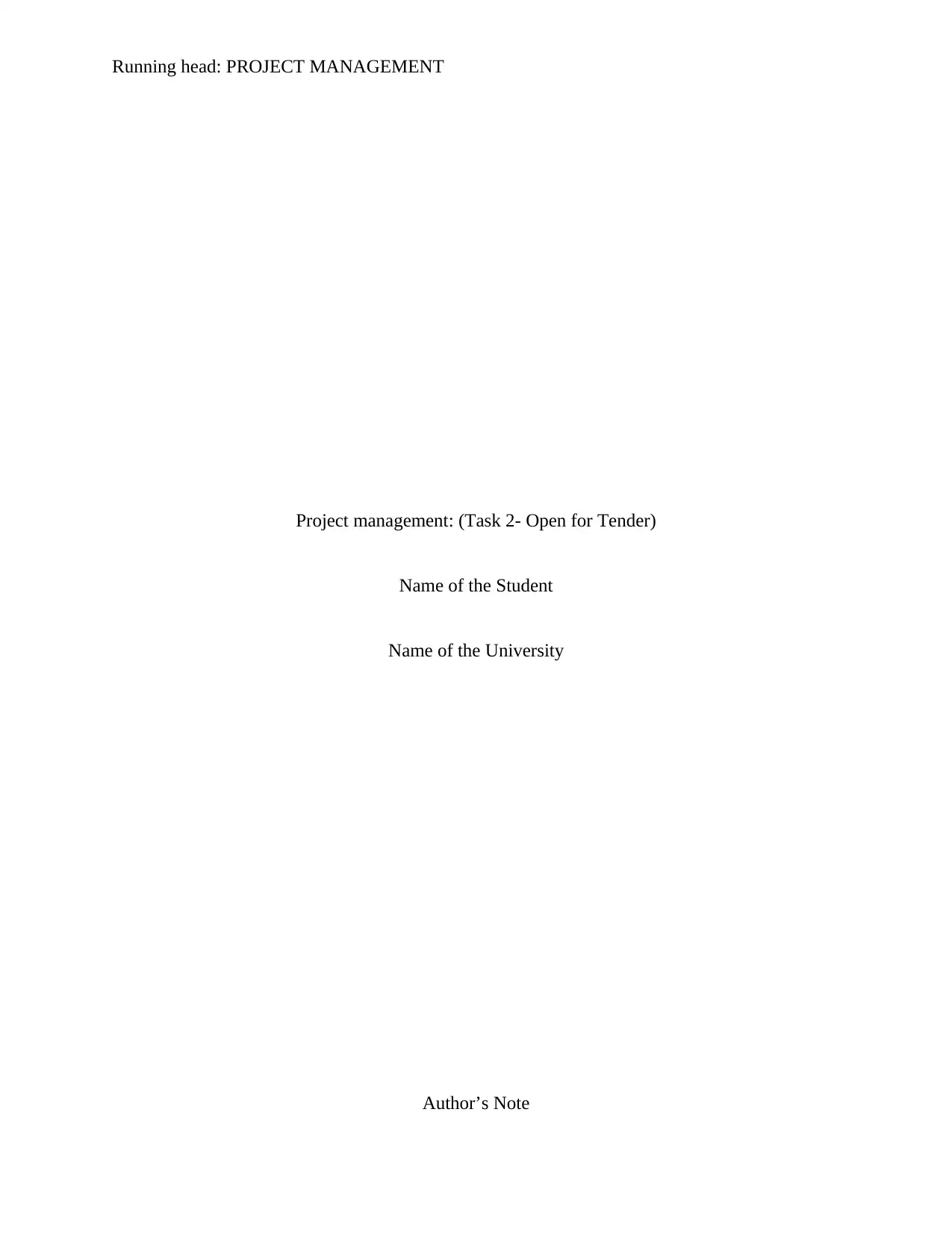
Running head: PROJECT MANAGEMENT
Project management: (Task 2- Open for Tender)
Name of the Student
Name of the University
Author’s Note
Project management: (Task 2- Open for Tender)
Name of the Student
Name of the University
Author’s Note
Paraphrase This Document
Need a fresh take? Get an instant paraphrase of this document with our AI Paraphraser
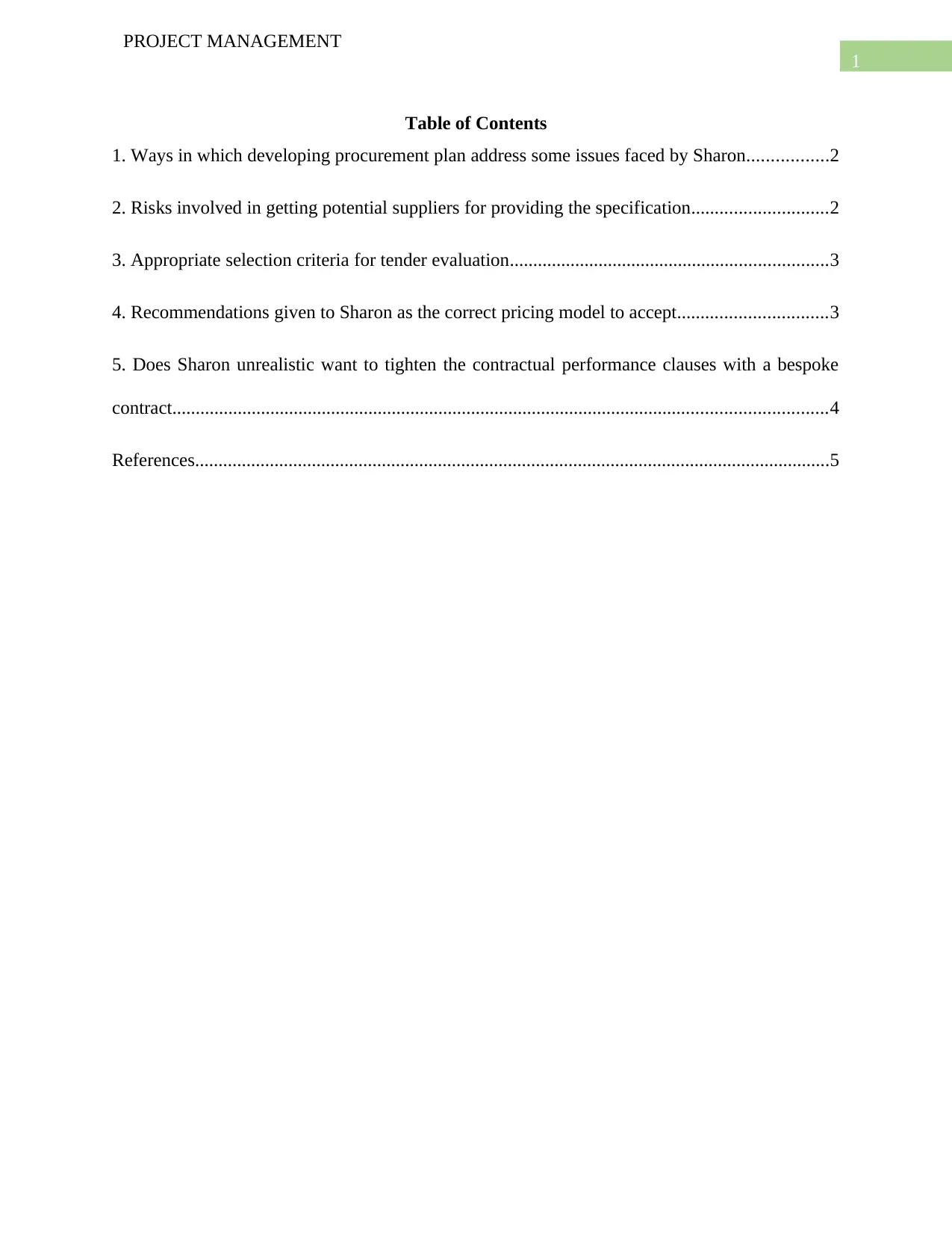
1
PROJECT MANAGEMENT
Table of Contents
1. Ways in which developing procurement plan address some issues faced by Sharon.................2
2. Risks involved in getting potential suppliers for providing the specification.............................2
3. Appropriate selection criteria for tender evaluation....................................................................3
4. Recommendations given to Sharon as the correct pricing model to accept................................3
5. Does Sharon unrealistic want to tighten the contractual performance clauses with a bespoke
contract............................................................................................................................................4
References........................................................................................................................................5
PROJECT MANAGEMENT
Table of Contents
1. Ways in which developing procurement plan address some issues faced by Sharon.................2
2. Risks involved in getting potential suppliers for providing the specification.............................2
3. Appropriate selection criteria for tender evaluation....................................................................3
4. Recommendations given to Sharon as the correct pricing model to accept................................3
5. Does Sharon unrealistic want to tighten the contractual performance clauses with a bespoke
contract............................................................................................................................................4
References........................................................................................................................................5
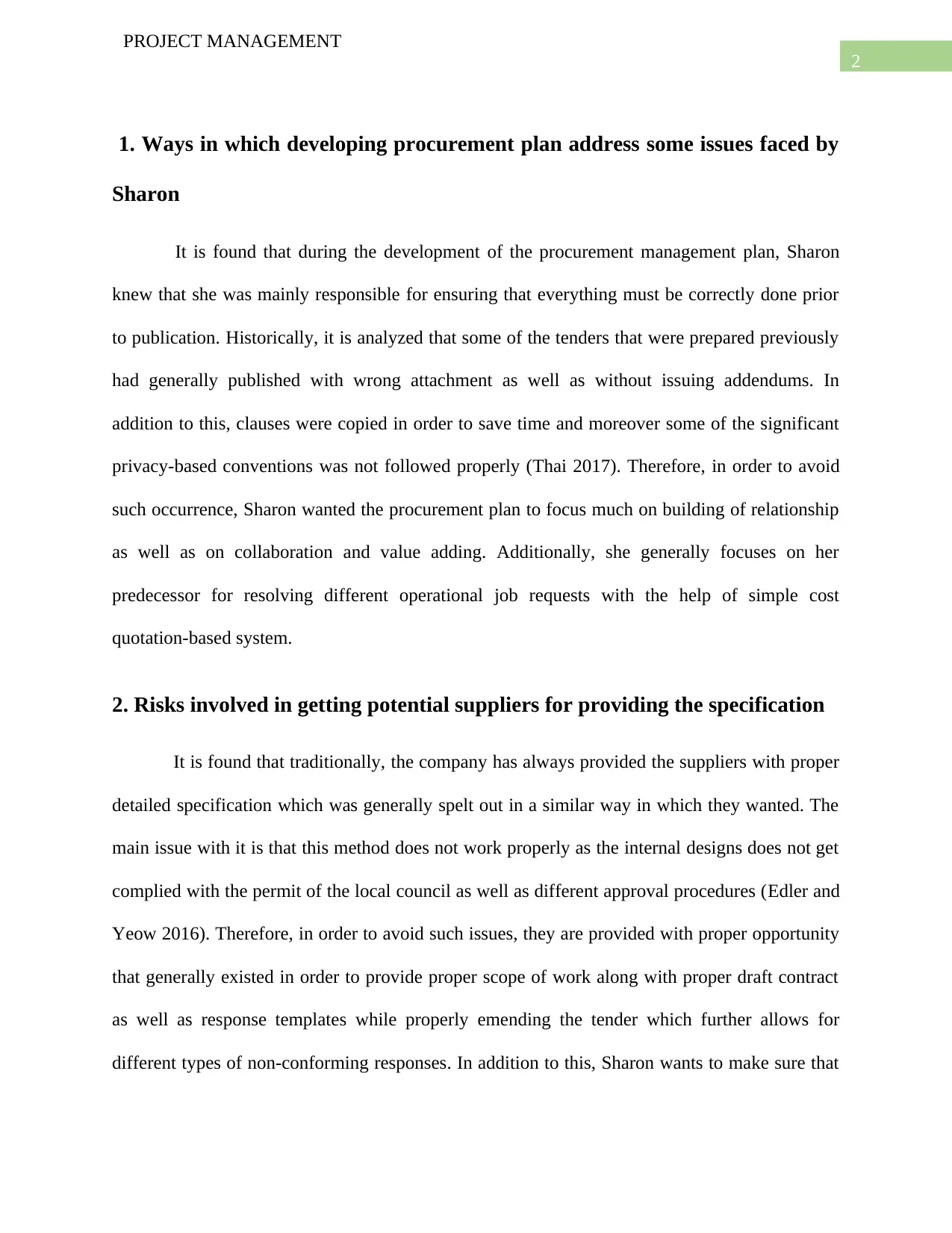
2
PROJECT MANAGEMENT
1. Ways in which developing procurement plan address some issues faced by
Sharon
It is found that during the development of the procurement management plan, Sharon
knew that she was mainly responsible for ensuring that everything must be correctly done prior
to publication. Historically, it is analyzed that some of the tenders that were prepared previously
had generally published with wrong attachment as well as without issuing addendums. In
addition to this, clauses were copied in order to save time and moreover some of the significant
privacy-based conventions was not followed properly (Thai 2017). Therefore, in order to avoid
such occurrence, Sharon wanted the procurement plan to focus much on building of relationship
as well as on collaboration and value adding. Additionally, she generally focuses on her
predecessor for resolving different operational job requests with the help of simple cost
quotation-based system.
2. Risks involved in getting potential suppliers for providing the specification
It is found that traditionally, the company has always provided the suppliers with proper
detailed specification which was generally spelt out in a similar way in which they wanted. The
main issue with it is that this method does not work properly as the internal designs does not get
complied with the permit of the local council as well as different approval procedures (Edler and
Yeow 2016). Therefore, in order to avoid such issues, they are provided with proper opportunity
that generally existed in order to provide proper scope of work along with proper draft contract
as well as response templates while properly emending the tender which further allows for
different types of non-conforming responses. In addition to this, Sharon wants to make sure that
PROJECT MANAGEMENT
1. Ways in which developing procurement plan address some issues faced by
Sharon
It is found that during the development of the procurement management plan, Sharon
knew that she was mainly responsible for ensuring that everything must be correctly done prior
to publication. Historically, it is analyzed that some of the tenders that were prepared previously
had generally published with wrong attachment as well as without issuing addendums. In
addition to this, clauses were copied in order to save time and moreover some of the significant
privacy-based conventions was not followed properly (Thai 2017). Therefore, in order to avoid
such occurrence, Sharon wanted the procurement plan to focus much on building of relationship
as well as on collaboration and value adding. Additionally, she generally focuses on her
predecessor for resolving different operational job requests with the help of simple cost
quotation-based system.
2. Risks involved in getting potential suppliers for providing the specification
It is found that traditionally, the company has always provided the suppliers with proper
detailed specification which was generally spelt out in a similar way in which they wanted. The
main issue with it is that this method does not work properly as the internal designs does not get
complied with the permit of the local council as well as different approval procedures (Edler and
Yeow 2016). Therefore, in order to avoid such issues, they are provided with proper opportunity
that generally existed in order to provide proper scope of work along with proper draft contract
as well as response templates while properly emending the tender which further allows for
different types of non-conforming responses. In addition to this, Sharon wants to make sure that
⊘ This is a preview!⊘
Do you want full access?
Subscribe today to unlock all pages.

Trusted by 1+ million students worldwide
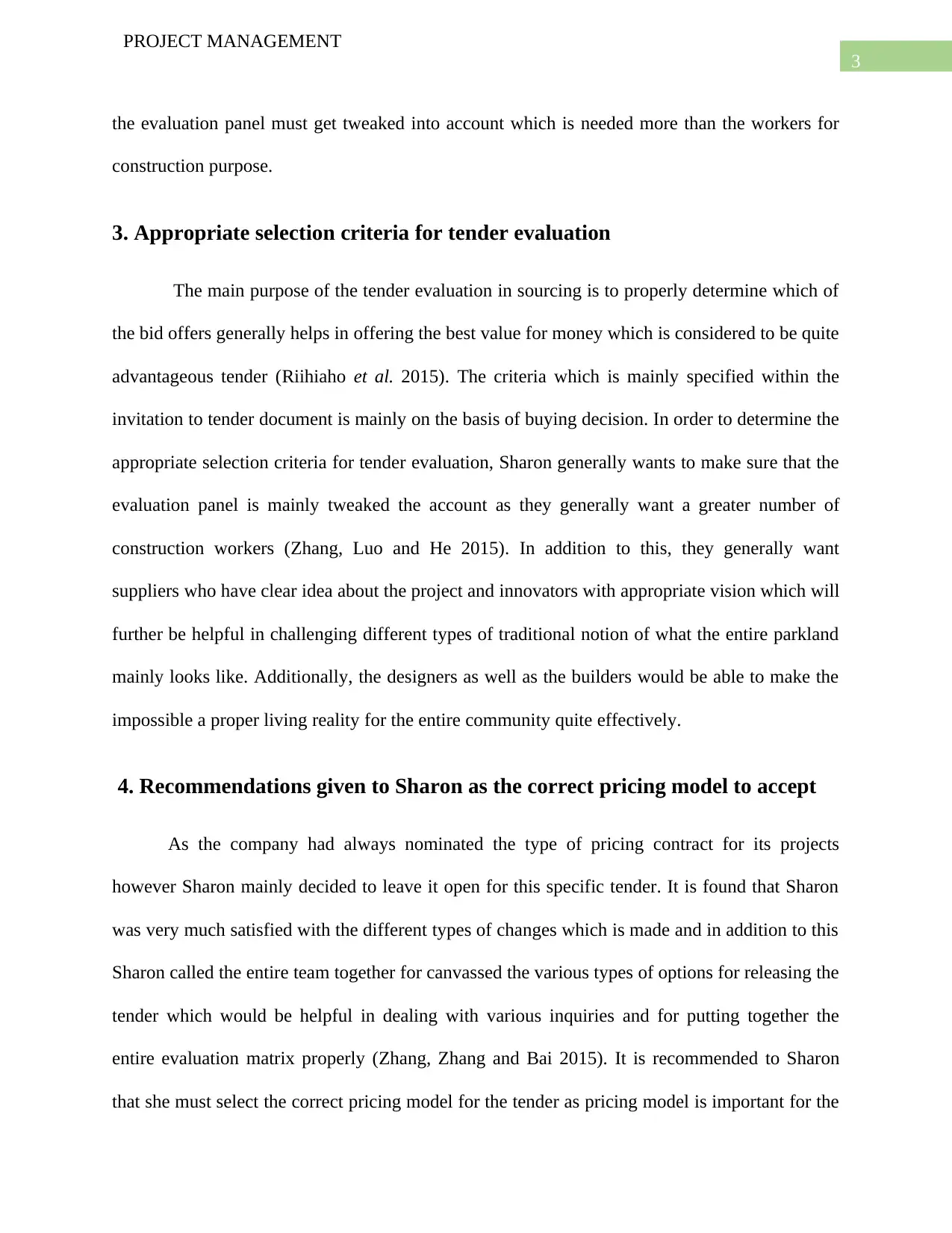
3
PROJECT MANAGEMENT
the evaluation panel must get tweaked into account which is needed more than the workers for
construction purpose.
3. Appropriate selection criteria for tender evaluation
The main purpose of the tender evaluation in sourcing is to properly determine which of
the bid offers generally helps in offering the best value for money which is considered to be quite
advantageous tender (Riihiaho et al. 2015). The criteria which is mainly specified within the
invitation to tender document is mainly on the basis of buying decision. In order to determine the
appropriate selection criteria for tender evaluation, Sharon generally wants to make sure that the
evaluation panel is mainly tweaked the account as they generally want a greater number of
construction workers (Zhang, Luo and He 2015). In addition to this, they generally want
suppliers who have clear idea about the project and innovators with appropriate vision which will
further be helpful in challenging different types of traditional notion of what the entire parkland
mainly looks like. Additionally, the designers as well as the builders would be able to make the
impossible a proper living reality for the entire community quite effectively.
4. Recommendations given to Sharon as the correct pricing model to accept
As the company had always nominated the type of pricing contract for its projects
however Sharon mainly decided to leave it open for this specific tender. It is found that Sharon
was very much satisfied with the different types of changes which is made and in addition to this
Sharon called the entire team together for canvassed the various types of options for releasing the
tender which would be helpful in dealing with various inquiries and for putting together the
entire evaluation matrix properly (Zhang, Zhang and Bai 2015). It is recommended to Sharon
that she must select the correct pricing model for the tender as pricing model is important for the
PROJECT MANAGEMENT
the evaluation panel must get tweaked into account which is needed more than the workers for
construction purpose.
3. Appropriate selection criteria for tender evaluation
The main purpose of the tender evaluation in sourcing is to properly determine which of
the bid offers generally helps in offering the best value for money which is considered to be quite
advantageous tender (Riihiaho et al. 2015). The criteria which is mainly specified within the
invitation to tender document is mainly on the basis of buying decision. In order to determine the
appropriate selection criteria for tender evaluation, Sharon generally wants to make sure that the
evaluation panel is mainly tweaked the account as they generally want a greater number of
construction workers (Zhang, Luo and He 2015). In addition to this, they generally want
suppliers who have clear idea about the project and innovators with appropriate vision which will
further be helpful in challenging different types of traditional notion of what the entire parkland
mainly looks like. Additionally, the designers as well as the builders would be able to make the
impossible a proper living reality for the entire community quite effectively.
4. Recommendations given to Sharon as the correct pricing model to accept
As the company had always nominated the type of pricing contract for its projects
however Sharon mainly decided to leave it open for this specific tender. It is found that Sharon
was very much satisfied with the different types of changes which is made and in addition to this
Sharon called the entire team together for canvassed the various types of options for releasing the
tender which would be helpful in dealing with various inquiries and for putting together the
entire evaluation matrix properly (Zhang, Zhang and Bai 2015). It is recommended to Sharon
that she must select the correct pricing model for the tender as pricing model is important for the
Paraphrase This Document
Need a fresh take? Get an instant paraphrase of this document with our AI Paraphraser
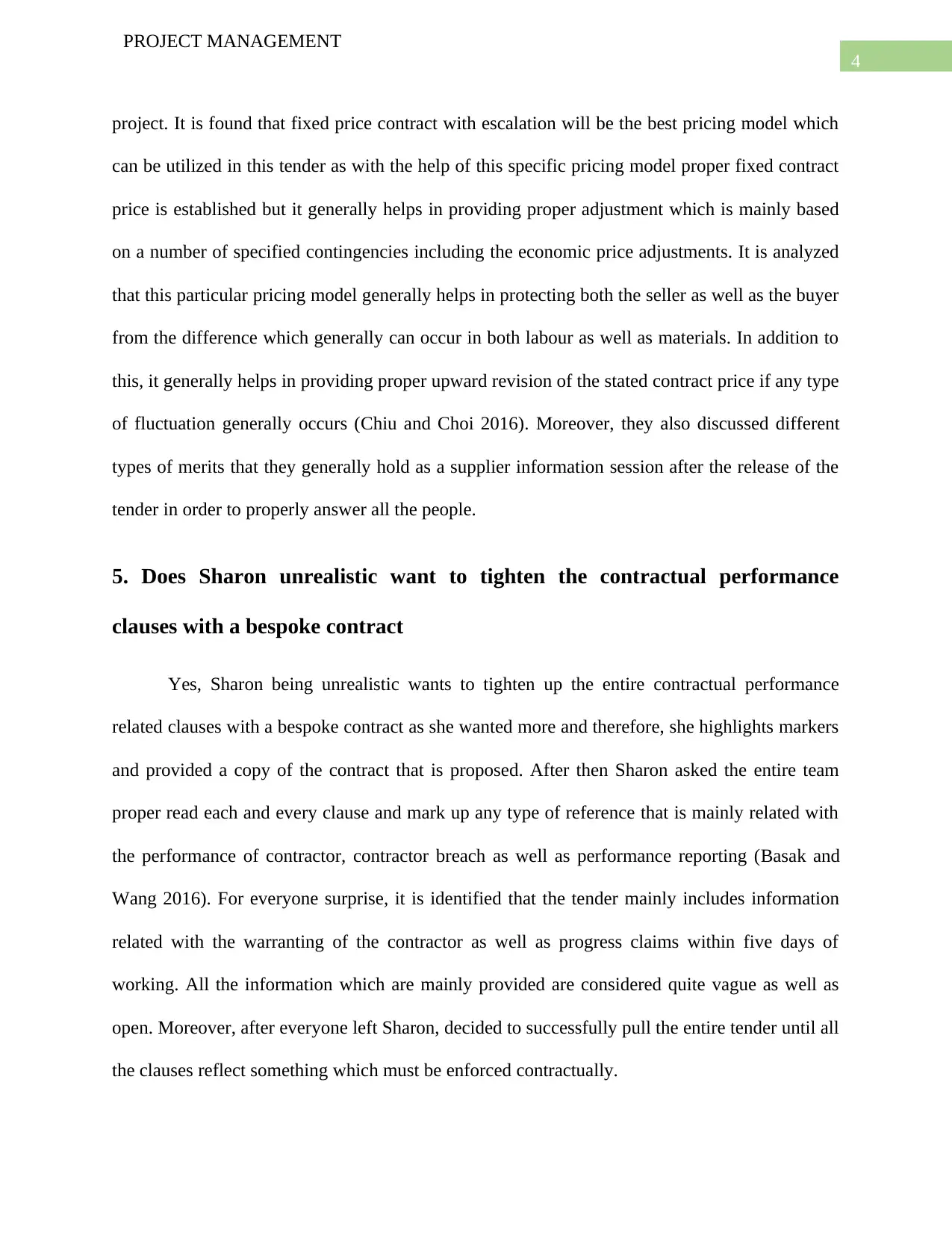
4
PROJECT MANAGEMENT
project. It is found that fixed price contract with escalation will be the best pricing model which
can be utilized in this tender as with the help of this specific pricing model proper fixed contract
price is established but it generally helps in providing proper adjustment which is mainly based
on a number of specified contingencies including the economic price adjustments. It is analyzed
that this particular pricing model generally helps in protecting both the seller as well as the buyer
from the difference which generally can occur in both labour as well as materials. In addition to
this, it generally helps in providing proper upward revision of the stated contract price if any type
of fluctuation generally occurs (Chiu and Choi 2016). Moreover, they also discussed different
types of merits that they generally hold as a supplier information session after the release of the
tender in order to properly answer all the people.
5. Does Sharon unrealistic want to tighten the contractual performance
clauses with a bespoke contract
Yes, Sharon being unrealistic wants to tighten up the entire contractual performance
related clauses with a bespoke contract as she wanted more and therefore, she highlights markers
and provided a copy of the contract that is proposed. After then Sharon asked the entire team
proper read each and every clause and mark up any type of reference that is mainly related with
the performance of contractor, contractor breach as well as performance reporting (Basak and
Wang 2016). For everyone surprise, it is identified that the tender mainly includes information
related with the warranting of the contractor as well as progress claims within five days of
working. All the information which are mainly provided are considered quite vague as well as
open. Moreover, after everyone left Sharon, decided to successfully pull the entire tender until all
the clauses reflect something which must be enforced contractually.
PROJECT MANAGEMENT
project. It is found that fixed price contract with escalation will be the best pricing model which
can be utilized in this tender as with the help of this specific pricing model proper fixed contract
price is established but it generally helps in providing proper adjustment which is mainly based
on a number of specified contingencies including the economic price adjustments. It is analyzed
that this particular pricing model generally helps in protecting both the seller as well as the buyer
from the difference which generally can occur in both labour as well as materials. In addition to
this, it generally helps in providing proper upward revision of the stated contract price if any type
of fluctuation generally occurs (Chiu and Choi 2016). Moreover, they also discussed different
types of merits that they generally hold as a supplier information session after the release of the
tender in order to properly answer all the people.
5. Does Sharon unrealistic want to tighten the contractual performance
clauses with a bespoke contract
Yes, Sharon being unrealistic wants to tighten up the entire contractual performance
related clauses with a bespoke contract as she wanted more and therefore, she highlights markers
and provided a copy of the contract that is proposed. After then Sharon asked the entire team
proper read each and every clause and mark up any type of reference that is mainly related with
the performance of contractor, contractor breach as well as performance reporting (Basak and
Wang 2016). For everyone surprise, it is identified that the tender mainly includes information
related with the warranting of the contractor as well as progress claims within five days of
working. All the information which are mainly provided are considered quite vague as well as
open. Moreover, after everyone left Sharon, decided to successfully pull the entire tender until all
the clauses reflect something which must be enforced contractually.
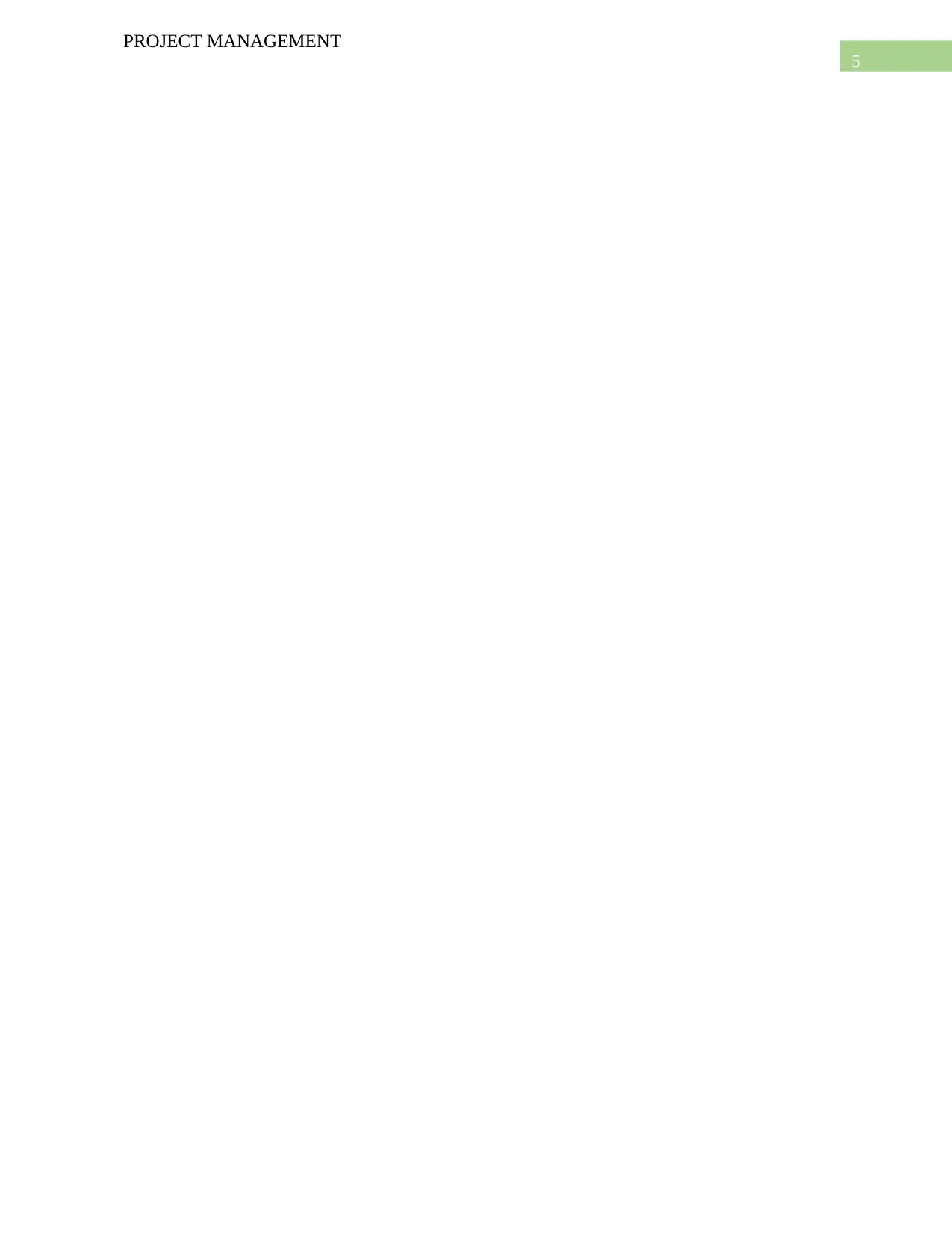
5
PROJECT MANAGEMENT
PROJECT MANAGEMENT
⊘ This is a preview!⊘
Do you want full access?
Subscribe today to unlock all pages.

Trusted by 1+ million students worldwide
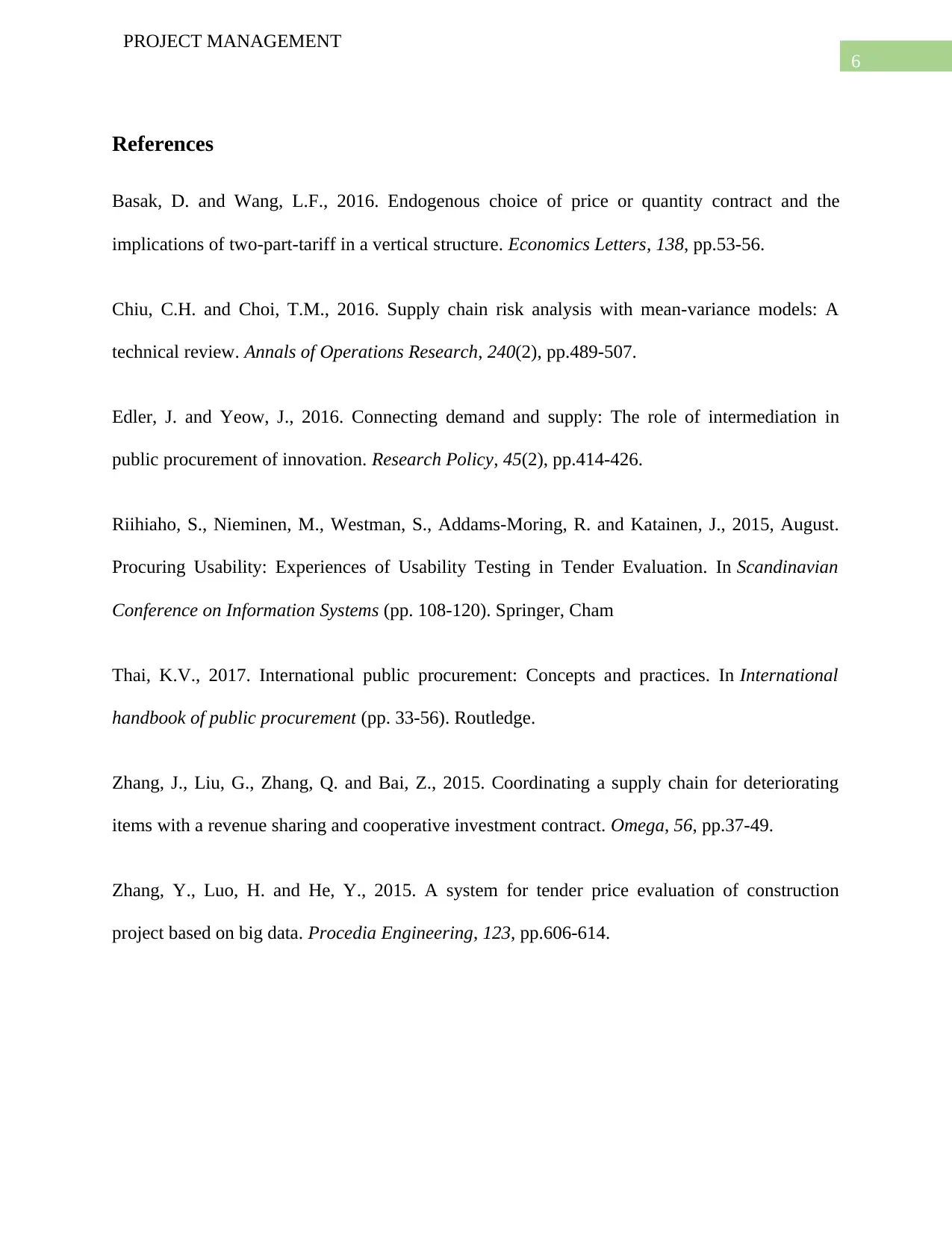
6
PROJECT MANAGEMENT
References
Basak, D. and Wang, L.F., 2016. Endogenous choice of price or quantity contract and the
implications of two-part-tariff in a vertical structure. Economics Letters, 138, pp.53-56.
Chiu, C.H. and Choi, T.M., 2016. Supply chain risk analysis with mean-variance models: A
technical review. Annals of Operations Research, 240(2), pp.489-507.
Edler, J. and Yeow, J., 2016. Connecting demand and supply: The role of intermediation in
public procurement of innovation. Research Policy, 45(2), pp.414-426.
Riihiaho, S., Nieminen, M., Westman, S., Addams-Moring, R. and Katainen, J., 2015, August.
Procuring Usability: Experiences of Usability Testing in Tender Evaluation. In Scandinavian
Conference on Information Systems (pp. 108-120). Springer, Cham
Thai, K.V., 2017. International public procurement: Concepts and practices. In International
handbook of public procurement (pp. 33-56). Routledge.
Zhang, J., Liu, G., Zhang, Q. and Bai, Z., 2015. Coordinating a supply chain for deteriorating
items with a revenue sharing and cooperative investment contract. Omega, 56, pp.37-49.
Zhang, Y., Luo, H. and He, Y., 2015. A system for tender price evaluation of construction
project based on big data. Procedia Engineering, 123, pp.606-614.
PROJECT MANAGEMENT
References
Basak, D. and Wang, L.F., 2016. Endogenous choice of price or quantity contract and the
implications of two-part-tariff in a vertical structure. Economics Letters, 138, pp.53-56.
Chiu, C.H. and Choi, T.M., 2016. Supply chain risk analysis with mean-variance models: A
technical review. Annals of Operations Research, 240(2), pp.489-507.
Edler, J. and Yeow, J., 2016. Connecting demand and supply: The role of intermediation in
public procurement of innovation. Research Policy, 45(2), pp.414-426.
Riihiaho, S., Nieminen, M., Westman, S., Addams-Moring, R. and Katainen, J., 2015, August.
Procuring Usability: Experiences of Usability Testing in Tender Evaluation. In Scandinavian
Conference on Information Systems (pp. 108-120). Springer, Cham
Thai, K.V., 2017. International public procurement: Concepts and practices. In International
handbook of public procurement (pp. 33-56). Routledge.
Zhang, J., Liu, G., Zhang, Q. and Bai, Z., 2015. Coordinating a supply chain for deteriorating
items with a revenue sharing and cooperative investment contract. Omega, 56, pp.37-49.
Zhang, Y., Luo, H. and He, Y., 2015. A system for tender price evaluation of construction
project based on big data. Procedia Engineering, 123, pp.606-614.
1 out of 7
Related Documents
Your All-in-One AI-Powered Toolkit for Academic Success.
+13062052269
info@desklib.com
Available 24*7 on WhatsApp / Email
![[object Object]](/_next/static/media/star-bottom.7253800d.svg)
Unlock your academic potential
Copyright © 2020–2025 A2Z Services. All Rights Reserved. Developed and managed by ZUCOL.





